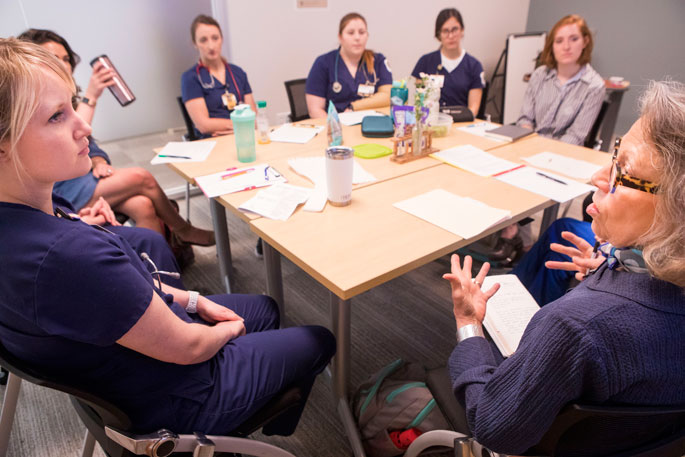A woman has just delivered a healthy baby, but received difficult news from her caregiver that will impact her health for the rest of her life. As a nurse attends to her physical needs, a chaplain is called in to provide comfort and pastoral care. The patient is relieved and happy her baby is OK, while grief-stricken and consumed by the news of her life-altering health condition.
The scenario appears all too real, but in fact, the “hospital room” is an authentically designed re-creation in a high-tech simulation laboratory at Vanderbilt University’s School of Nursing. The grieving mother is actually a standardized patient — a trained actor — and those providing care are Vanderbilt nursing and divinity master’s students in training. The exercise is part of a unique collaboration between Vanderbilt’s nursing and divinity schools to offer interprofessional learning opportunities and a unique approach to improving patient care.
“As nurses we know what to do with blood, we know how to fix the wounds, but we don’t always know how to deal with the emotional side of things, the personal problems patients may be dealing with,” says VUSN student Noelle Sabatt. “The pastoral team is trained to deal with these issues and I saw that first hand through the simulation training. It’s so great that we will have them in the hospital setting to collaborate with — that we’re not on our own.”
VUSN’s newly opened $23.6 million expansion includes the state-of-the-art Simulation and Skills Lab, which provides experiential and immersive learning and supports interprofessional collaboration opportunities for students across the institution.
“As nurses we know what to do with blood, we know how to fix the wounds, but we don’t always know how to deal with the emotional side of things.”
–VUSN student Noelle Sabatt
“We frequently find in the hospital setting that the nursing staff does their work over here and pastoral care does their work over there, and there’s not the collaboration that we’d like to see,” says Lucinda Stewart, assistant professor, VUSN. “This simulation training helps promote that collaboration. It teaches the students how to interact with other professionals and how to provide a holistic experience for that patient — because the mind and the body are so intertwined.”
Trudy Hawkins Stringer, associate director of field education and assistant professor in the Divinity School, worked with Stewart and VUSN Assistant Professor Sally Miller to create the simulation exercise. “What we are finding is that there is not a lot of crossover and knowledge about what each profession does,” Stringer says. “We want the nursing students to feel comfortable calling on pastoral services and chaplains to understand more deeply what the nurses do so they can serve the patient holistically.”
The Nursing School’s impressive new expansion fronts 21st Avenue, with the simulation lab comprising the building’s entire third floor. Boasting sophisticated technology and advanced equipment, it has 13 meticulously recreated “care bays” where students learn how to respond to potential scenarios in emergency, obstetrics, pediatric, bedside, practitioner office, neonatal nursery and other settings.

Video cameras in the bays record and transmit the simulations to observation rooms where students and faculty can watch the proceedings in real time. After participating, students engage in guided debriefing with feedback from faculty and classmates.
“We can read about theory, but what really matters most is how we respond when we are in that room with people who need our care.”
–Divinity student Caleb Hampton
“We can read about theory, but we know that what really matters most is how we will respond when we are in that room with people who need our care,” says divinity student Caleb Hampton. “As a new chaplain we may not understand all of the aspects of what the nurses do, so the simulations — and especially the debrief sessions afterwards — really give us this extra awareness of how we can work together to provide the best possible care for patients.”
The joint simulation has been more than four years in the making. This is the third year they’ve collaborated, and the first collaboration in VUSN’s new building.
“Vanderbilt has an initiative to support and encourage interdisciplinary teaching and learning. The deans of the two schools envisioned this opportunity to engage across disciplines,” Stringer says. “Based on the research we’ve done, I would say Vanderbilt is really on the cutting-edge as far as institutionally promoting interdisciplinary and interprofessional teaching and learning.”

The faculty have presented the work at local, regional, national and international nursing and clinical simulation conventions. Their manuscript on the qualitative findings will be published in the Clinical Simulation in Nursing later this year.
For more information, contact: nancy.wise@vanderbilt.edu